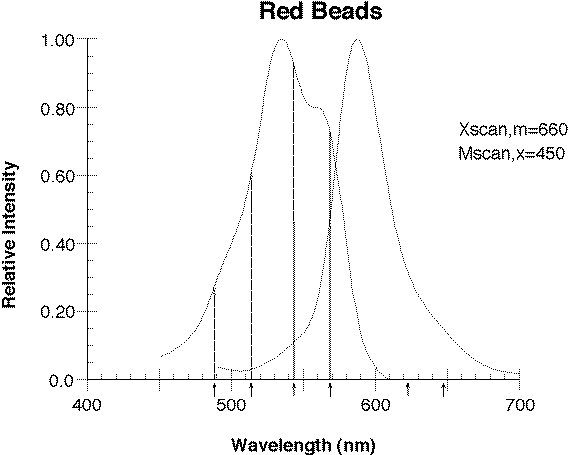RetroBeads Gamma Lumafuor is the first reverse tracer product of lumafuor company, and it is the only one that has been proved to be effective (the effectiveness of this product has been confirmed by hundreds of research papers from invertebrate to mammalian experiments). At present, lumafuor's green and red fluorescent tracer particles can only be purchased from our company.
The tracer product is highly concentrated in vivo injection, not easy to spread, strong signal, non-toxic to living cells or living bodies, and the survival time is more than one year. It is compatible with most of the following tracer, in situ hybridization detection technology and immunohistochemistry technology.
Some product information is as follows:
Red Retrobeads (100 µl)
Green Retrobeads IX (100 µl)
Red Retrobeads Gamma IX(100µl)
This manual summarizes most of the procedures for using fluorescent latex microspheres (beads) as a retrograde tracer for neurons. For information on green beads, please refer to the end of this manual. For more detailed information, please refer to the following papers by Katz, L.C
1.Katz,L.C.,Burkhalter,A.,andDreyer,W.D.FluorescentlatexmicrospheresasaretrogradeneuronalMarkerforinvivoandinvitros tudiesofvisualcortex.Nature310 :498-500(1984)
2.Katz,L.C.andIarovici,D.M.Greenfluorescentlatexmic rospheres:anewretrogradetracer.Neuroscience34 :511-520(1990)
Operating instructions for lumafuor efficient retrobeads
1、 Packaging and dilution:
Lumafuor's beads were packed in a sealed vial and the concentrated beads were suspended in distilled water. If red beads are used as the reverse tracing of neural pathway, the dilution method is recommended: 1:4 dilution can be used in rat visual cortex without reducing the intensity and quality of fluorescence labeling of beads. However, for the first experiment, we do not recommend the use of diluted beads, but use the original solution for injection tracing. In addition to distilled water, conventional salt solutions such as NaCl and KCl can also be used as diluents. If green beads is used, it is strongly recommended to use the stock solution without dilution.
2、 Storage:
In order to avoid evaporation, bead solution should be stored in the refrigerator for 4 degrees. Do not freeze it! Frozen beans will be useless and unusable. The dried beads also cannot be used (can not be re suspended), and the product has no obvious service life. If stored as required, it can be stored for several years.
3、 Injection:
Beads is best to use pressure injection, such as 1ml Hamilton microinjector or pneumatic injection system. If small area microinjection (30-50nl) is needed, glass electrode with 30-50um diameter at the end can be used for injection, while glass electrode with larger diameter can be used for conventional reverse tracing (injection volume 0.1-0.3ul). However, even at a higher dose, beads does not diffuse significantly from the injection site (usually less than 1 mm). Therefore, in order to label neurons projecting to a larger nucleus as completely as possible, multi-point injection is needed. Although beads are negatively charged, ion permeation method is not recommended for tracing beads.
4、 Survival time:
In most thermostatic vertebrate systems, the shortest effective time for detection of beads is 24 hours. Within 48 hours, the labeling intensity increases with the injection time, and the fluorescence intensity remains constant after 48 hours. In cold-blooded animals, the recommended time for detection of beads is 1 week. At present, the longest detectable period of beads has not been detected. However, the fluorescence intensity and quality of beads can remain unchanged for at least 14 months in vivo, and cells may be permanently labeled. No toxic effects of beads have been found in animals or neurons.
5、 Fixation and treatment:
The standard fixation method is: 0.1mpbs is washed or perfused and fixed in 4% paraformaldehyde (0.1mpbs preparation, pH7.4). Fixation with glutaraldehyde will produce a lot of tissue autofluorescence, which will hinder the neurons labeled with beads. Moreover, green beads will not be completely observed in glutaraldehyde fixed tissues, so it should be avoided as far as possible. If frozen section is used, the slices should be rinsed with PBS and dried with gelatin coated slide. After air drying, the slides should be transparent with xylene for 1 minute, and then sealed with fluoromount or krystalon. Fluoromount can be purchased from atomrgic chemetals Corp. (Farmingdale, NY); krystalon can be purchased from
Harleco (EM industries, Gibbstown, NJ). Slices can only be exposed to ethanol or xylene for a short time, but long-term exposure (more than 5 minutes) can damage beads. Beads is very sensitive to glycerol, and fluorescence will be quickly extracted in glycerin environment. Therefore, glycerin sealing agent should not be used. If it is unavoidable, methyl salicylate can be used instead of glycerin as sealing agent. If the slices were stored in dark environment, the cells labeled with fluorescent beads could not be extracted for one year (but the fluorescence background of the slices would increase). So far, there is no record of beads labeled tissue coated with plastic materials.
Observation:
The dye in red beads is rhodamine, so all fluorescent filters matched with rhodamine can be used. Some old rhodamine filters of Nikon company may not be able to observe fluorescent beads due to their high background. Generally, standard rhodamine filters of Zeiss and Leitz can obtain better observation effect. Most of the green fluorescent filters can observe the fluorescence results of green beans well. The filter set to fluorescent yellow can obtain strong bright fluorescence, but it also brings high background interference. The results show that a wider band of fluorescent filter than a narrow band filter can obtain stronger fluorescence signal. After a long period of observation and photographing, the fluorescence of beads did not




